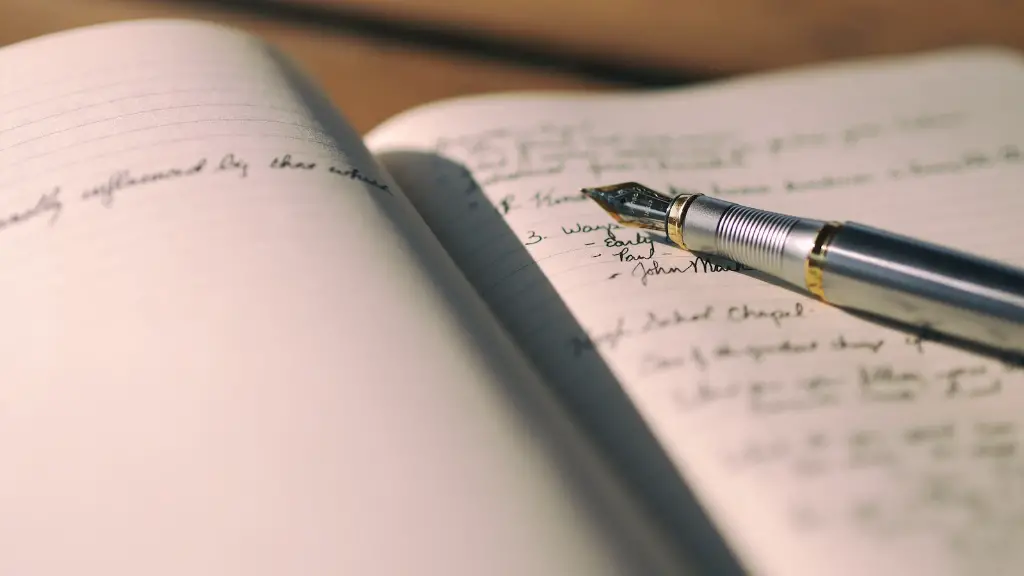Overview
Iambic verse is a type of poetic meter that has been popular throughout centuries of literature. It is a type of unrhymed verse characterized by a symmetrical pattern of alternating short and long or stressed and unstressed syllables that provides a certain rhythm. The syllables can be grouped into pairs, known as feet, with the long or stressed syllable followed by the short or unstressed syllable in what is known as an “iamb.” This form of rhythm is the most important factor in determining the structure of the works of many major poets, including Shakespeare, Milton, and Wordsworth.
History
The term “iambic” is derived from the Greek word “iambos” which means “a two-syllable foot.” This type of meter has been around since the earliest days of Greek and Latin poetry. Over the centuries, it has been adapted by a variety of poets and writers in different languages and geographical regions. Many of today’s popular forms of poetry, including sonnets, odes, and epic poems, also contain iambic meter.
How it works?
Iambic meter consists of a series of feet, each composed of an unstressed syllable followed by a stressed syllable. The feet most commonly used in iambic verse are known as “iambs.” The rhythm of this type of meter is considered to be the most natural to the English language because it reflects the natural rhythm of spoken language. A typical line of iambic verse would look something like this:
“The sky was blue and bright.”
As you can see, the words are broken into two syllables, with the first syllable unstressed and the second syllable stressed. This pattern is repeated in each line of iambic verse.
Particularly Relevant Examples
The works of William Shakespeare are an excellent source of examples of iambic verse. Much of the poetry written by the Bard makes use of iambic meter. The famous lines “To be, or not to be…” from his famous play, Hamlet, are structured in iambic pentameter—a type of iambic verse composed of five feet. You can also find examples of iambic pentameter in John Milton’s Paradise Lost and William Wordsworth’s The Prelude.
Variations
Although most iambic verse consists of five feet, many variations exist. Iambic dimeter, for example, is composed of two feet and is often used in comic poetry. Iambic hexameter is another type of iambic verse, composed of six feet and is often used in epic poems.
The Significance of Iambics in Poetry
Iambic verse is an important tool for poets as it provides a natural rhythm that reflects the sounds of spoken language and helps to shape the poetic structure. It is also a valuable tool for poets seeking to express their ideas in a specific way and create rime or structure with the use of meter. Furthermore, it enables poets to express their ideas in a meaningful and dynamic way, while making use of the natural rhythm of the English language.
The Beauty of Iambics in Poetry
Iambic verse is also a helpful tool for poets who wish to convey a certain beauty or emotion through their work. Through the use of iambic meter, poets can create a sense of harmony and rhythm in their work that can be pleasing to the ear. The use of iambic meter can also prove to be an effective way to emphasize certain words or phrases and allow for a more varied interpretation of the poem’s meaning.
Analysis of the Iambic Pattern
Iambic meter is a great tool for writers looking to inject their work with a certain rhythm and meaning. Through the use of iambic patterns, poets and writers are able to emphasize certain words and phrases and create a pleasing and dynamic reading experience. The use of iambic meter also allows for a more meaningful interpretation of the poem’s contents as the rhythm lends itself to the exploration of deeper meanings and emotions.
Exploring the Different Versions of Iambics in Poetry
Iambic meter is a flexible form of poetry that can be adapted to fit a variety of different scenarios. There are different versions of iambic meter, such as dimeter, trimeter, tetrameter, pentameter, and hexameter, that can be used to express different ideas and emotions. Additionally, by combining different versions of iambic meters, poets can create unique and interesting poems that stand out from the crowd.
Pros and Cons of the Iambic Structure
Using iambic meter in poetry can be both beneficial and detrimental, depending on the poet’s intention. On the one hand, it gives structure and control to a poem, which can help give a poetic work a more meaningful interpretation. However, it can also be limiting as it does not allow for much creativity when it comes to experimenting with different types of poetic forms and structures.
Exploring the Possibilities with Iambics
Despite the potential drawbacks, iambic meter can still be used to create unique and powerful poetry. Through the use of the different versions of iambic meter, poets can create a range of textures and emotions and explore various aspects of language and experience. By combining different versions of iambic meter, poets can create fluid and interesting works that are both unique and meaningful.


